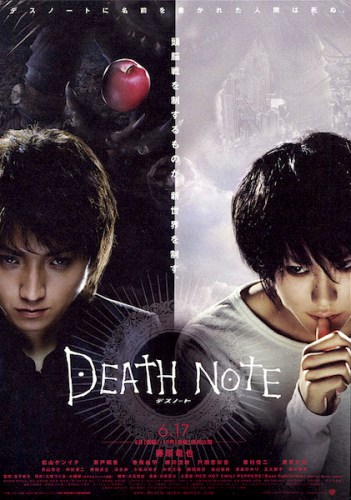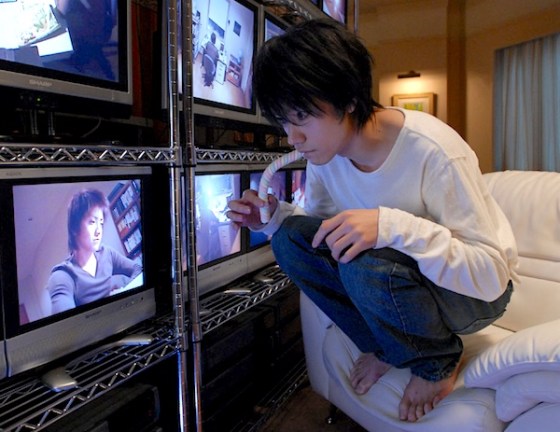Shūsuke Kaneko | 121 mins | DVD | 16:9 | Japan / Japanese | 12

Something of a worldwide phenomenon in the ’00s, Death Note started life as a manga and is perhaps best known for its anime adaptation, but it was also adapted into a series of live-action films, the first of which actually predates the anime.
In case the whole thing passed you by, it’s the story of student Light Yagami (Battle Royale’s Tatsuya Fujiwara) who discovers a supernatural notebook, the titular Death Note, that was dropped by death-god Ryuk (voiced by Shidou Nakamura). Whenever a name is written in the Death Note, that person drops dead. Light begins to use it to execute criminals who’ve escaped justice, a pattern of killings that is quickly noticed by the police and the media, who dub the mysterious murderer “Kira”. While much of the public agree with his actions, the police are stumped in their investigations. Also on the case is a reclusive genius detective known only as ‘L’ (Kenichi Matsuyama), who quickly suspects Light of being Kira, initiating a game of cat and mouse between the pair.
It’s a good setup for a story, a premise that invites moral conundrums and “what would you do?” questions. I can see why it appealed to young people, too — what youth hasn’t wished certain annoying people would just drop dead? (Some places banned the manga because its popularity was leading to kids making their own Death Note books, writing in names of classmates and teachers. Obviously they didn’t actually work, but it was a “psychological health” thing.)

There’s not much plot in that idea, mind: the Death Note is so all-powerful that there’s little drama in Light using it, especially as he isn’t morally conflicted himself — he’s sure he’s doing the right thing, despite people around him voicing their disagreement with Kira. The story therefore comes to focus on the battle between Light and L, a pair of self-proclaimed geniuses who work to constantly outwit each other. This is where the film begins to falter, because a lot of their supposed intelligence comes from leaps of logic designed to make them look clever.
It’ll also be a problem for any viewers who need a likeable protagonist: although Light starts out aiming to do good, he’s gradually led to be a right evil bastard; on the other side, L is an irritating brat, walking around barefoot, weirdly crouching on chairs, always stuffing his face with sugary treats, and speaking cryptically to the level-headed coppers forced to work with him. I’ve said before that I don’t think a film necessarily needs a likeable hero to work, but it does feel odd that there’s no one to root for here. Partly I don’t think the film’s sure whose side we should be on. It’s made to feel like it should be Light’s, but the film also knows he’s not got the strongest moral compass.

This “duel of the geniuses” eventually comes to a head in a neatly-conceived climax, but one which doesn’t wrap everything up — the film ends on a very “end of part one” note. Although this film is simply called Death Note and the second was released here as Death Note 2, in Japan they were marketed as a “two-part event” and released just months apart. So I guess the cliffhanger ending is fair enough — it’s not an attempt at launching a franchise (an annoying trend when sequels aren’t produced), but is instead no different than The Matrix sequels, or Kill Bill, or so on.
That said, the production schedule to make that happen is somewhat interesting, especially as it clearly had an influence over the film’s quality. The duology was produced at extraordinary speed. The concept of a two-film adaptation was greenlit in November 2005, Shūsuke Kaneko signed on as director in December, and they were shooting by the start of February 2006. Film 1 was shot in February and March, then came out in the middle of June, just three months later. Film 2 was still being written during Film 1’s post-production, before shooting in June and July, and was released at the start of November, just two months later. There were six assistant directors, including people who’d already graduated to helming their own films, just to handle the volume of work required to fit in the tight schedule — two major movies from script to screen in under 12 months. It’s no wonder the production looks a bit TV-ish at times, with somewhat dull cinematography and Ryuk realised through cheap and cheerful CGI. More vitally, the script or edit probably could’ve done with greater attention, to iron out some of those logic leaps and improve the pace in the middle.

The final work still manages to be an enjoyable thriller with a supernatural conceit — a film which definitely has its moments, especially as Light begins to work with the Death Note’s rules to creative effect — but it needed more polish, the legacy of its speedy production resulting in an array of niggles.

The US remake of Death Note is released on Netflix this Friday.
